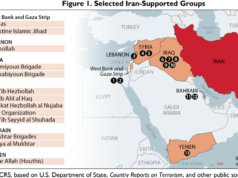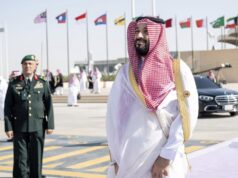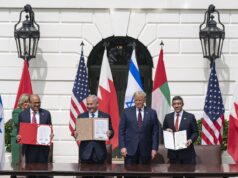China has implemented a deft strategy to peel the Middle East away from the United States. Most observers have fixated on the fact that China is doing this to lay claim to the vast oil and natural gas wealth that exists beneath the sands of the region.
Certainly, this is true.
What China Wants
Yet, China’s plan goes much deeper than just control over the fossil fuel. China wants to partner with and gain access to the budding high-tech development projects occurring throughout the region. In places like the Kingdom of Saudi Arabia and Israel, cutting-edge scientific innovation is underway that will directly impact the outcome of the Fourth Industrial Revolution.
The Fourth Industrial Revolution is the name experts have given to our current moment of socioeconomic development. It is the creation of new innovations in the fields of biotechnology, quantum computing, artificial intelligence, metamaterials, hypersonic technologies, Fifth-Generation (5G) and Sixth-Generation (6G) communications, to just name some advances. The nation that innovates most in these new domains will be the dominant superpower for the next century.
Previously, the Second and Third Industrial Revolutions were dominated by the United States. This was the true source of America’s power and the reason the US has been the world’s dominant superpower for as long as it has been.
However, according to the Australian Strategic Policy Institute (ASPI), China dominates 37 out of the 44 key areas of the Fourth Industrial Revolution.
Beijing is now scaling up this impressive dominance beyond the high-tech sector and applying geopolitics to its quest to be the Fourth Industrial Revolution-controlling superpower (thereby making America and the rest of the world subordinate to Beijing). China’s autocrats are looking to their west, seeking out new development grounds in the one region that most Americans want little involvement with: the Middle East.
China is the world’s second-largest economy (in GDP terms) and the world’s largest economy in terms of Purchasing Power Parity (PPP). Its economy has traditionally grown at an astonishing clip. Even in the recent years, when China was not enjoying double-digit economic growth rates, its growth was measured to be much higher than America’s consistently meager increases.
Yet, China needs new markets to sustain itself. It simply cannot remain totally insulated. Chinese firms have branched beyond their territory, going as far afield as Latin America, Africa, and now the Middle East. More important though, are China’s wider strategic ambitions.
Military-Civil Fusion Enters the Mideast
Chinese firms, in fact, are merely the vanguard of China’s growing state power; projectors of China’s soft power (which appears more as an iron fist in a velvet glove).
The Middle East has long been considered an American sphere of interest. Costly, brutal wars have been waged by the United States and its allies in the region to ensure its dominant position there. Despite this, for a fraction of the cost, China has slid into the region underneath America’s nose just after the United States concluded those wars.
And China is using its technology firms as the spearhead.
For China, the intention is not only to control the greater Middle East. Chinese leaders’ ambitions are far larger. The Mideast is, after all, the crossroads of civilization—the place where Asia links with Europe and even Africa, all regions that China wants to have greater influence over. So, moving the Middle East into China’s expanding sphere of influence will place Beijing in a position to connect all the other regions.
It’s a silent takeover of Eurasia, the Middle East, and Africa through all measures short of war.
In the Chinese context of military-civil fusion (MCF), business isn’t just business. It is a vehicle for China’s military and strategic ambitions. The connections forged between the region’s governments and business elite will ensnare them in a new Chinese security architecture being built before our very eyes.
Military-Civil Fusion is China’s strategy for making it the dominant superpower by linking its civilian and military industrial capacities into a cohesive entity. China already has a world-class manufacturing sector. Its leaders have spent years and billions of dollars and years building a high-tech innovation infrastructure to rival America’s.
Chinese firms—notably the country’s technology firms—compete globally against those of other countries. The benefit these companies have when seeking contracts abroad is that they bring with them the backing of the Chinese state, making them more competitive than other, private firms.
China’s MCF has proven to be highly effective method for expanding and increasing global power relative to that of the United States. This is painfully obvious in the Middle East, where Chinese firms—notably tech businesses—are moving at an alarming rate.
The presence of these firms (as well as other Chinese initiatives to win over the region’s great powers) means that America is increasingly at a disadvantage. More disconcerting is how little Washington has paid attention to these developments—or even how America has allowed these developments to occur with its short-sighted foreign policy toward the Middle East.
A Different Approach
Whereas Americans have used military might and diplomatic pressure, Beijing has taken a more circumspect approach. It wants to link economic and political interests with those of the region’s power players. As Beijing’s rulers argue, they want a partnership rather than what they claim is American imperialism. After years of US military action, China’s appeals are increasingly enticing to the embattled regimes of the region.
From Israel to Saudi Arabia, the Americans have alienated the Middle East’s traditional American partners. The Biden administration has made a consistent case against Saudi Arabia’s Crown Prince Muhammad Bin Salman (MBS) on human rights grounds. The Biden team wants MBS punished for his apparent role in the gruesome murder of Washington Post Op-Ed writer (and former spy, according to many accounts) Jamal Khashoggi in 2019.
Beyond that, Washington wants Saudi Arabia to rein in its overall human rights abuses.
However, with each criticism of Saudi Arabia’s leadership over human rights matters, Washington drives Riyadh farther away and into the waiting arms of the People’s Republic of China, which has no moral qualms about marrying itself to Saudi power in the region. And in the case of Chinese human rights abuses toward the Muslim, Turkic Uyghurs of Western China, the Saudis and the rest of the Muslim states in the region turn a blind eye.
This is partly because the Saudis want to do business with China. Although, it is likely more because the members of the Saudi elite who get sick and require organ transplants receive the organs of Uyghur prisoners in China via the black market and can know that these organs were halal—clean according to Islamic religious law, unlike the illicitly harvested organs of China’s Falun Gong or Tibetan political prisoners.
Saudi Vision 2030 and China’s Rise
Saudi Arabia is transitioning from an oil-dominated economy toward what MBS refers to as “Saudi Vision 2030.” By taking public a large share of Saudi ARAMCO, the country’s oil conglomerate, the Crown Prince hopes to create a new Saudi-led Silicon Valley in the desert that would make his country more than just one of the world’s leading oil producers.
By 2025, Saudi Arabia is slated to spend $25.4 billion on indigenous high-tech development, considered the most substantial investment into high-tech development in the world. Analysts have also projected that an additional $6.4 billion in developing future technologies will be spent by the Saudis over the next several years.
Saudi Arabia is, by far, the largest market in the region—with a volume exceeding $40 billion, according to Suparna Dutt D’Cunha of the online publication, Fast Company Middle East.
China wants to be on the ground floor. That is one critical reason Beijing waded into Saudi Arabia’s dispute with Iran and brokered a peace deal between the two.
The only problem facing Riyadh in its high-tech enterprise is that the Saudi workforce cannot meet increased demand to fill high-tech jobs. Saudi Arabia not only needs to invest in high-tech innovation hubs, but it will also need to invest in massive retraining programs for the population.
This will prove more problematic for Saudi Arabia since its push for high-tech innovation has outpaced the country’s commitment to reeducating its workforce.
Not to worry, though. If China can complete its push to reorient Saudi Arabia from the United States and toward China’s orbit, Beijing could do for the Kingdom what it has done for many other countries with which it has done business: China can move its own workers into the country, filling in whatever positions in the new high-tech industry are needed, allowing Riyadh to continue its transition from leading oil producer to a major high-tech power.
After the Chinese-brokered peace deal between Saudi Arabia and Iran, China’s state-backed telecommunications firm, Huawei, announced it will move its Middle East headquarters to the Saudi capital of Riyadh.
But that is just the start of China’s movement into the Middle East.
China Really Wants Israel
The Chinese true target is Israel. In that progressive democracy exists one of the world’s most advanced high-tech industries. Silicon Wadi (wadi is Arabic for “stream bed”) is a term used to describe the various business parks in Israel that have sprouted up over the decade. These areas emulate and work closely with Silicon Valley firms to produce next-generation technology.
Specifically, Israel is pioneering the development of critical biotech and quantum computing advancements that China’s rulers are simply ga-ga over. There’s also Israel’s budding space sector which China has already attempted to gain access to.
Recently, Israeli start-ups in that dynamic nation-state have begun proliferating in nuclear fusion. One firm, NT-Tao, has secured $28 million in venture capital funding to create a nuclear reactor small enough to fit into a cargo container.
This Israeli firm has attracted the likes of major corporate backers, such as the Japanese automaker, Honda. The automaker’s leadership has said its investment into NT-Tao gives the firm “great hope” in terms of the venture’s profitability, its potential to innovate this critical technology, and how it can change the world by providing affordable, efficient, nearly limitless clean energy.
China is dying to get more involved in these ventures. By pushing Americans out of the region and replacing US power with that of China via the Military-Civil Fusion approach, Chinese firms hope to gain access to these Israeli ventures. They could be in position to pilfer such innovations (as they have done repeatedly to the United States and the rest of the West), incorporate this new technology into their own base, and use it to further enhance both China’s economy as well as its military capabilities relative to those of the United States.
China’s Dance
Because of Israel’s American-like tech development practices, the tiny democracy is now a target of what David P. Goldman refers to as “Sino-Forming,” that is China’s practice of remaking the world in its own image.
We were told by Beijing’s allies (of which there are far more than Washington is willing to acknowledge) that China’s entry into the Middle East as arbiter of a new regional order would herald peace and harmony for everyone.
Yet, before the ink dried on the Saudi-Iran rapprochement, Iranian-backed militants from Hezbollah in Lebanon began popping rockets off at neighboring Israel. The Netanyahu government can expect more olive branches like this from China-backed Iran.
That’s because China is fomenting this newfound instability. By icing tensions between Riyadh and Tehran, Beijing is creating an axis of autocrats against the democracies—of which Israel is the only one in the region. It’s not that China wants to destroy Israel. Beijing wants, through China’s Iranian proxies, to pressure Israel’s leaders into abandoning their alliance with the United States.
In so doing, Beijing hopes to isolate Israel from its traditional allies and then force Jerusalem to turn to China (and Russia) for help in keeping the nuclear-arming Iranians from destroying Israel.
Beijing’s Pound of Flesh
The price of such a deal would be complete access to Israel’s high-tech sector; to turn Israel into a conduit for China’s growing high-tech Belt-and-Road Initiative (BRI) that stretches from mainland China all the way to Israel’s Mediterranean coastline. Israel would be absorbed in China’s growing Eurasia-and-Africa-wide trade belt that would empower Beijing at Washington’s expense.
By fusing China’s impressive high-tech sector with the growing high-tech development sectors of Saudi Arabia and Israel, China not only would ensure its dominance of the geo-strategically vital Middle East but also would elevate its game in the ongoing race to dominate the Fourth Industrial Revolution.
Beijing effectively would make the rest of the world dependent on Chinese-developed high-tech infrastructure in much the same way the Americans made the world dependent on American-developed high-technologies in the previous two industrial revolutions. Without a shot. Forget about Taiwan. China is devouring the geopolitical system. Taiwan’s collapse after Beijing finishes eating the world would be assured—and no one could stop Beijing at that point even if they wanted.
Americans, meanwhile, are busy arguing about which gender they are.
As a former president might tweet, Sad!
Brandon J. Weichert is a senior editor at 19FortyFive and a contributor at The Washington Times, American Greatness, and Asia Times. He is the author of Biohacked: China’s Race to Control Life (Encounter Books), and The Shadow War: Iran’s Quest for Supremacy (2023). He can be followed via Twitter @WeTheBrandon.





